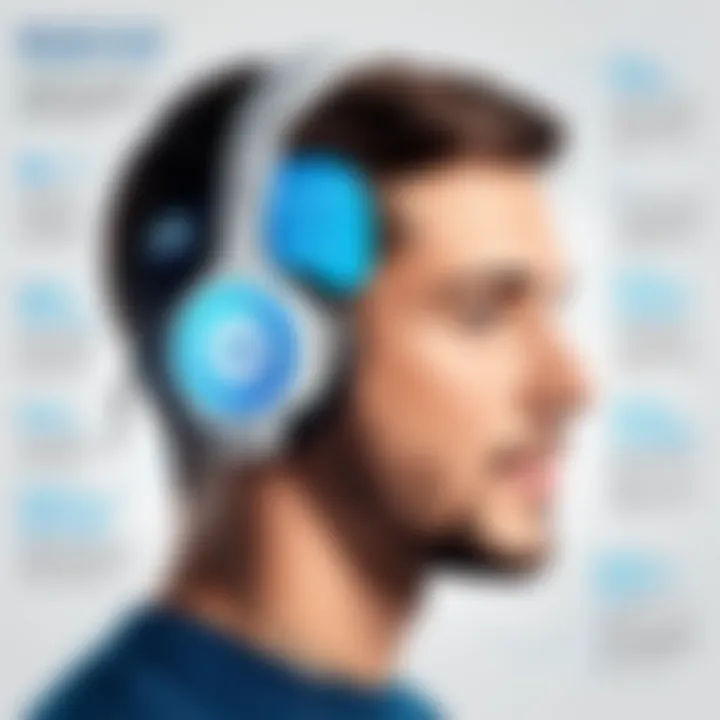Exploring Voice Recognition Technology: Speech to Text Apps


Intro
Voice recognition technology has rapidly evolved over recent years, finding relevance in various industries. The ability to transcribe speech into text is not only a remarkable feat of innovation, but also a practical tool for many professionals. As organizations embrace digital transformation, these applications improve efficiency, collaboration, and inclusivity in the workplace. This article seeks to unpack the components behind speech-to-text applications and their implications for users.
The functionality of these applications relies heavily on advanced algorithms and linguistic models, often enhanced by machine learning techniques. This method of functioning yields high accuracy rates, thereby reducing the frustration often associated with traditional typing methods. Understanding this technology's core elements is crucial for IT professionals and tech enthusiasts who aim to leverage its benefits.
Product Overview
Key Features
Some of the key features of prevalent speech-to-text applications include:
- High Accuracy: Most modern apps reach noteworthy accuracy levels, accommodating various accents and dialects.
- Real-Time Transcription: These tools convert spoken language into text instantaneously, allowing for seamless communication.
- Integration: Compatibility with other software and tools ensures that speech recognition apps can be utilized in diverse workflows, such as Google Docs or Microsoft Word.
- Usability: User-friendly interfaces promote ease of use, even for those less technically inclined.
- Language Support: Many applications support multiple languages, widening their applicability across global teams.
Technical Specifications
When examining technical specifications, users will find various factors impacting performance:
- Speech Recognition Algorithms: These algorithms analyze sound waves and convert them into recognizable speech patterns.
- Machine Learning Models: Training models enhance the application's understanding of language nuances.
- Cloud Processing: Some applications rely on cloud-based technologies, enabling a broader processing capacity and improving results.
The combination of these specifications contributes to the overall performance and reliability of speech-to-text technology.
Performance Analysis
Benchmark Test Results
Performance metrics often vary by application. However, test results generally indicate that leading applications can achieve upwards of 95% accuracy under optimal conditions. Keeping environment constraints—like background noise—minimum, these benchmarks serve as a baseline for real-world applicability.
Real-World Usage Scenarios
In practical settings, speech-to-text applications can dramatically enhance productivity. Possible scenarios include:
- Meetings: Transcribing discussions in real time to aid in record-keeping.
- Dictation: Allowing professionals to compose texts hands-free while multitasking.
- Accessibility: Offering solutions for individuals with disabilities, ensuring everyone can participate equally in professional environments.
"Speech recognition technology creates pathways for productivity that were previously unattainable, transforming how we engage with information handling."
In summary, voice recognition applications present multi-faceted benefits, from bolstering productivity to promoting inclusivity. By understanding both the technological underpinnings and practical applications, IT professionals can make informed decisions on integrating these tools into their work environments.
Preface to Speech-to-Text Applications
Speech-to-text applications have seen a notable rise in demand, largely due to the growing need for efficient communication tools in various sectors. Their significance lies not only in enhancing productivity but also in fostering accessibility for individuals with disabilities. Understanding these applications requires an in-depth look at their technological foundations, benefits, and real-world implications.
The importance of this topic is further underscored by the rapid advancements in voice recognition technology. As more organizations seek to automate processes, speech-to-text applications become essential tools. They enable professionals to convert spoken language into written text quickly, reducing the time and effort usually associated with manual transcription.
Moreover, these applications provide substantial advantages for users who might face challenges in traditional text input methods. By utilizing natural language processing and machine learning algorithms, they can accurately interpret diverse accents and dialects, making communication smoother across various environments.
In exploring the topic, we must consider various elements such as:
- The technological advancements that drive accuracy in speech recognition.
- The application of these technologies in different professional settings.
- The ethical and privacy concerns that accompany their use.
Overall, the journey into speech-to-text applications reveals a fascinating intersection of technology and human interaction, making them an essential focus for professionals and enthusiasts alike.
The Rise of Voice Recognition Technology
Voice recognition technology has evolved significantly over the years. Initially, speech recognition systems were limited in their capabilities, often struggling to understand variations in pronunciation. However, advancements in algorithms and processing power have led to more sophisticated systems, capable of handling complex spoken input.
As smartphones and voice-activated assistants like Siri, Alexa, and Google Assistant became mainstream, the acceptance of voice recognition technology increased. These consumer-level applications paved the way for the adoption of more specialized speech-to-text tools in professional sectors. Companies began to realize the potential for efficiency and accuracy, fueling further research and development.
Defining Speech-to-Text: Key Concepts
To fully grasp how speech-to-text applications work, it is important to define some key concepts. At their core, these applications leverage automatic speech recognition (ASR). ASR technology takes an audio input and converts it into readable text by analyzing the sound waves.
Key components of speech-to-text applications include:


- Acoustic Model: This component represents the relationship between phonetic units and audio signals. It is crucial for accurately recognizing speech.
- Language Model: It predicts the likelihood of word sequences based on known grammar and vocabulary. A good language model helps in understanding the context of spoken words.
- Decoder: This is the final stage where the chosen model outputs the most likely text representation of spoken words.
By integrating these components, speech-to-text applications have become increasingly reliable and user-friendly. Their continued evolution is an area of excitement in both the tech industry and academia.
Technical Foundations of Speech Recognition
Understanding the technical foundations of speech recognition is critical to grasp the technology's capabilities and limitations. These foundations comprise the algorithms, models, and processes that enable apps to convert spoken language into written text. The efficacy of these applications heavily relies on the robustness of these underlying mechanisms. As voice recognition technology continues to evolve, the importance of these technical aspects cannot be overstated.
Understanding Natural Language Processing
Natural Language Processing (NLP) is a branch of artificial intelligence that focuses on the interaction between computers and human (natural) languages. It plays a pivotal role in speech recognition. NLP allows software to understand, interpret, and generate human language in a meaningful way. Within the context of speech recognition, NLP comprises various tasks, such as phonetic transcription, semantic understanding, and contextual analysis of spoken inputs.
NLP models help bridge the gap between spoken language's diverse nature and the requirements of formal data processing. The technology enables applications to comprehend variations in tone and inflection, enhancing the accuracy of speech recognition systems.
Algorithmic Approaches to Speech Recognition
The mechanisms that facilitate speech recognition are predominantly rooted in algorithmic approaches. The main methodologies employed in this domain include Hidden Markov Models and Deep Learning Techniques.
Hidden Markov Models
Hidden Markov Models (HMM) have played a fundamental role in speech recognition since their inception. These models represent systems that transition between a series of hidden states, a structure that is highly suitable for sequential data like speech. HMMs capture the temporal dynamics of spoken language effectively.
One key characteristic of HMM is its ability to statistically model the sequences in speech. This property makes it a popular choice for applications handling natural language. However, while HMMs provide a reliable basis for many systems, they can struggle with variability in speech, such as accents and speech speed, which can lead to inaccuracies.
Deep Learning Techniques
Deep Learning Techniques have revolutionized the field of speech recognition in recent years. These methods involve neural networks with multiple layers that can learn hierarchies of features from the data. A distinctive feature of deep learning is its ability to process large datasets effectively, facilitating enhanced recognition performance.
The strength of deep learning lies in its flexibility, making it a favorable approach for modern applications. However, while deep learning yields impressive results, it requires significant computational resources and extensive datasets for training, which can be a limitation in resource-constrained environments.
Challenges in Accurate Speech Recognition
Despite advancements in technology, ensuring accuracy in speech recognition remains a challenge. Two primary challenges are Accent and Dialect Variability and Background Noise Interference.
Accent and Dialect Variability
Accent and Dialect Variability poses significant hurdles. As speech can vary dramatically based on a speaker's regional or cultural background, training models on uniform datasets may not adequately represent this diversity. This can lead to reduced accuracy when the system encounters accents or dialects it has not been specifically trained on.
Addressing this variability is crucial for inclusivity and functionality. Relying on diverse datasets during training can help the system improve its ability to recognize various speech patterns. However, it requires more extensive and varied data collection efforts.
Background Noise Interference
Background Noise Interference significantly impacts the ability of speech recognition systems to process spoken inputs accurately. Noisy environments can cause misinterpretations and errors, particularly if the model is not optimized for noise reduction. Recognizing speech amidst significant ambient noise remains a leading concern in the development of speech recognition technology.
Many current systems try to utilize advanced techniques for noise cancellation, yet the effectiveness can vary. It is crucial for developers to focus on enhancing this aspect to improve the system's overall reliability in varied environments.
Popular Voice Recognition Applications
Voice recognition applications play a crucial role in today's technological landscape. Their growth has not only improved accessibility but also reshaped how businesses operate. These applications enable users to convert spoken language into text. This capability has practical implications in various sectors such as customer service, healthcare, and education. The convenience and efficiency these applications bring cannot be understated. By utilizing voice recognition, professionals can increase productivity and minimize manual tasks. This section will explore both commercially available solutions and open-source alternatives, providing a comprehensive view of the tools available today.
Commercially Available Solutions
Google Speech Recognition
Google Speech Recognition is a fundamental technology that powers various voice recognition applications. One of its key characteristics is its high accuracy rate. This solution benefits from Google's extensive data resources, continually improving its performance. Its integration with other Google services adds to its flexibility, making it a popular choice among businesses and developers. The unique feature of Google Speech Recognition is its support for multiple languages and accents. This aids in making it adaptable to diverse users. However, it does require an internet connection for optimal functioning, which can be a limitation in specific scenarios.
Microsoft Azure Speech Service
Microsoft Azure Speech Service stands out for its robust features and seamless integration with Azure’s broader ecosystem. The key characteristic of this service is its scalability. Organizations can easily adjust their usage according to business needs. The unique feature of Microsoft Azure Speech Service is its ability to personalize voice models based on user data. This creates a more tailored experience for end-users. One consideration with this service is its pricing structure, which may not be suitable for all small enterprises. Despite this, its comprehensive tools for speech recognition make it an attractive option for many companies.
Open Source Alternatives for Developers
CMU Sphinx


CMU Sphinx is an influential open-source project that has contributed significantly to the field of speech recognition. Its standout characteristic is flexibility. Developers can customize the tools to meet specific project needs. CMU Sphinx also supports a range of programming languages. This makes it an appealing choice for a variety of tech professionals. A unique feature of CMU Sphinx is its emphasis on offline speech recognition, allowing for usage without constant internet access. However, the trade-off may be a more complex setup for those unfamiliar with the technology.
Kaldi
Kaldi has gained recognition for its advanced capabilities and targeted functionalities in speech recognition. A primary aspect of Kaldi is its powerful toolkit, which attracts researchers and developers alike. The highlight of Kaldi is its use of state-of-the-art machine learning algorithms, facilitating high accuracy. Its unique feature is the modular design, which allows developers to build customized solutions easily. Despite its strengths, Kaldi may have a steeper learning curve than some alternatives, making it potentially challenging for new users.
Understanding the offerings in voice recognition technology is essential for making informed decisions related to application development and implementation.
By analyzing both commercial and open-source options, professionals can select solutions that best fit their specific needs. Each application has different strengths and limitations, which should be carefully considered.
Applications of Speech-to-Text Technology
The significance of speech-to-text applications lies in their potential to streamline workflows, enhance communication, and facilitate better accessibility across various platforms. These applications utilize advanced algorithms to transcribe spoken language into written text, providing immediate benefits for many users. Key elements include efficiency, fast access to information, and the ability to manage tasks hands-free.
One of the central benefits of using speech-to-text technology is its impact on productivity. Professionals can capture ideas quickly without manually typing notes or documents. Additionally, these applications often incorporate machine learning, which allows them to improve from user interactions. However, they do require ongoing adaptation to users' speech patterns, accents, and terminologies, which can present challenges in maintaining accuracy.
Use Cases in Professional Settings
Transcription Services
Transcription services represent one of the most notable applications of speech-to-text technology. They aid in converting verbal discussions, interviews, and meetings into written format. This service enhances documentation, making information retrieval significantly more manageable. A key characteristic of transcription services is their ability to provide timely and accurate records of spoken content, which is essential in sectors like healthcare or law.
A unique feature of transcription services lies in their versatility. They can be used in diverse environments, from recording business meetings to documenting academic lectures. Although effective, their reliance on technology means that errors can occasionally occur, especially in environments with multiple speakers or when background noise is present.
Customer Support Automation
Customer support automation is another key area where speech-to-text applications excel. In many organizations, these technologies are employed to enhance customer service operations by transcribing customer queries and routing them to the appropriate support agents. This automation enables quicker response times, mitigating delays in service. A defining feature of customer support automation is its capability to handle high volumes of inquiries simultaneously, which is critical for maintaining customer satisfaction.
Furthermore, automated systems can analyze transcriptions for patterns, helping businesses refine their procedures. However, they can sometimes struggle with understanding intricate queries from customers or fail to capture the nuances of human emotion in correspondence, leading to less personalized interactions.
Enhancing Accessibility for Users with Disabilities
Assistive Technologies
Assistive technologies that employ speech-to-text solutions are designed to empower users with disabilities by making information more accessible. These technologies can convert spoken commands into text or execute tasks in response to voice instructions. This accessibility opens up a new world of possibilities for individuals, ensuring they can participate equitably in various domains, from education to community engagement.
The key advantage of assistive technologies lies in their ability to customize features to match the needs of users, improving their productivity and interaction. Still, the effectiveness of these tools can vary based on the user’s specific requirements and the accuracy of the voice recognition software employed.
Real-Time Captioning
Real-time captioning enhances the way people consume information by providing live transcription of spoken content during events or broadcasts. It allows individuals to follow along in real-time, thereby significantly benefiting users who are deaf or hard of hearing. A prominent characteristic of real-time captioning is its immediacy—captions are generated as the speech occurs, which creates a seamless experience for viewers.
Despite its benefits, real-time captioning can face challenges such as differentiation among speakers and difficulties in maintaining accuracy in complex dialogues. Additionally, the nuances of spoken language can be difficult to capture in live settings, leading to potential misrepresentation of the original message.
Advantages of Voice Recognition Applications
Voice recognition applications have revolutionized the way we interact with technology. Their advantages extend across industries and personal use, making tasks easier and more efficient. This section explores key benefits, specifically focusing on increasing productivity and facilitating hands-free operations.
Increasing Productivity and Efficiency
One of the prime advantages of voice recognition is its ability to enhance productivity. By converting speech to text, these applications allow users to create documents, notes, or messages without the need for traditional typing. This feature is particularly beneficial in fast-paced environments where time is often a constraint. For instance, professionals can quickly dictate meeting notes or ideas as they come, rather than interrupting their workflow to type.
Furthermore, voice recognition systems minimize the cognitive load associated with manual input. When tasks become more streamlined, employees can focus on more strategic elements of their work rather than the minutiae of note-taking or data entry. This increase in efficiency translates into time savings. Many users report that they can accomplish tasks significantly faster using voice commands instead of keyboard typing.
As an example, using Google Speech Recognition, professionals can create emails or reports swiftly. The capability to easily recall earlier transcriptions and make edits through voice commands adds another layer of efficiency.
"Voice recognition applications not only save time, but they also empower users to engage in multitasking without compromising quality."
Facilitation of Hands-Free Operations
The hands-free aspect is another significant advantage of voice recognition technologies. It allows users to perform tasks without the need to interact physically with devices. This is especially advantageous in scenarios where hands are occupied or where maintaining focus on a task is essential. For instance, in a field service environment, technicians can continue working while giving voice commands to access crucial data or log their findings.
Additionally, people with disabilities benefit immensely from hands-free capabilities. Those who may struggle with traditional input methods find that voice recognition provides more independence and ease of access. Applications designed for assistive technology offer real-time text processing, translating spoken words into written formats instantly.


In both professional and personal contexts, hands-free operation increases convenience. It allows individuals to engage with their devices while performing other activities, such as driving or cooking.
By utilizing voice recognition technology, organizations can create a more inclusive workplace where everyone can participate fully regardless of their ability to use standard input devices.
Limitations and Considerations
Understanding the limitations and considerations associated with voice recognition technology is crucial. Despite the advances in speech-to-text applications, there are significant factors that both users and developers must evaluate carefully. These elements not only impact user experience but also shape the future landscape of voice recognition technology. In this section, we will explore two primary concerns: accuracy issues and privacy considerations.
Accuracy Concerns
Accuracy is a paramount aspect of speech recognition systems. Misinterpretation of spoken language can lead to miscommunication, potentially affecting outcomes in professional settings. Factors like an individual’s accent, speech clarity, and even background noise can heavily influence the precision of transcriptions.
For instance, non-standardized pronunciations can confuse algorithms, leading to significant errors. Many applications still struggle to effectively handle diverse accents and dialects, resulting in a biased user experience. Moreover, the presence of overlapping sounds or ambient noise can skew results. For optimal functionality, users must be in controlled environments, which is not always feasible.
"Accurate transcription is not just about the technology; it's about ensuring that the technology adapts to different vocal inputs."
To address these challenges, ongoing improvements in deep learning and natural language processing techniques are essential. Developers must keep refining algorithms to better recognize varied speech patterns and reduce error rates. Nonetheless, a consistent level of accuracy may remain elusive, demanding users to remain vigilant in verifying transcriptions.
Privacy and Data Security Issues
Another notable concern regarding voice recognition technology involves privacy and data security. The nature of speech data makes it inherently sensitive. Transcriptions may expose personal information, business secrets, or private conversations. This risk raises alarms for users who prioritize confidentiality.
Many applications store audio data in cloud services. This storage poses a threat if appropriate security measures are not in place. Incidents of data breaches in technology have heightened apprehensions about how these systems handle sensitive information. It is essential for users to determine how their data is collected, used, and protected by service providers.
To mitigate risks, users should opt for applications that offer end-to-end encryption and clear privacy policies. Transparency from developers regarding data usage is vital for building trust. Furthermore, users must be educated about their rights relating to data protection, such as the option to delete recorded data.
In summary, while the advantages of voice recognition technology are numerous, limitations related to accuracy and privacy cannot be overlooked. Awareness of these issues is necessary for informed utilization of these systems.
Future Directions in Speech Recognition Technology
The field of speech recognition technology is experiencing rapid advancement. This section reflects on the emerging trends and potential future developments. As applications adopt more intelligent frameworks, it is crucial to understand the implications of these advancements. Focus shifts to how integration with AI can significantly enhance speech recognition. Additionally, potential innovations warrant attention as they may redefine user interaction with technology.
Integration with Artificial Intelligence
Integrating artificial intelligence with speech recognition represents a critical progression in this field. AI enhances the capability of speech apps by providing a more nuanced understanding of linguistic variations. This includes recognizing context, tone, and even emotional content within spoken words. The development of natural language processing (NLP) models powered by AI allows applications to interpret commands and inquiries with improved efficiency.
Benefits of AI integration include:
- Increased accuracy in transcription through context awareness.
- Personalized experiences for users based on prior interactions.
- Learnability, where systems adapt to individual speech patterns over time.
Moreover, AI systems can analyze voice data more effectively, helping to distinguish between different speakers and dialects. This will not only improve the end-user experience but also facilitate broader adoption across diverse user bases.
"The fusion of AI and voice technology is reshaping communication, pushing toward a more seamless interface between humans and machines."
Potential Innovations on the Horizon
There are several noteworthy innovations anticipated in the realm of speech recognition technology. These include:
- Real-time translation features, allowing users to converse across language barriers effortlessly.
- Enhanced contextual understanding through multi-modal interaction, where voice input is combined with visual cues.
- Voice synthesis improvements that make machine-generated speech sound increasingly natural.
Another area of exploration is the integration of wearable devices, enabling hands-free and continuous interaction with speech recognition systems. This can lead to advancements in fields like telemedicine, where patients engage with healthcare providers using voice commands in a secure manner.
As developers continue to innovate, these enhancements underscore the potential to transform and expand applications of speech recognition in everyday contexts.
The ongoing evolution in this sector signals a promising outlook for the future, elevating both user experience and application functionality.
End
The conclusion serves as a vital element in this article, reinforcing the importance of understanding voice recognition technology and its various applications. As we have explored, speech-to-text applications have made significant strides not only in technical sophistication but also in their practical utility across diverse professional settings. This has implications for productivity, communication, and accessibility.
Summary of Key Points Discussed
In the preceding sections, we have dissected numerous facets of voice recognition technology. Key takeaways include:
- Advancements in Algorithms: Understanding the core algorithms, such as Hidden Markov Models and deep learning techniques, reveals the complexity underlying speech recognition.
- Practical Applications: The technology's use in transcription services and customer support automation highlights its immediate benefits in professional environments.
- Challenges and Limitations: Issues related to accuracy, privacy, and the impact of background noise present ongoing challenges that need addressing.
- Future Prospects: The integration of AI into voice recognition technology suggests exciting developments on the horizon.
Final Thoughts on the Future of Voice Recognition
As voice recognition technology continues to evolve, its potential applications are likely to expand beyond current capabilities. The incorporation of artificial intelligence and machine learning will enhance accuracy and ease of use, making these tools even more accessible. With the rapid digital transformation across industries, individuals and organizations that adopt these technologies will gain competitive edge.
In a world increasingly reliant on seamless communication, mastering voice recognition applications can redefine productivity and user experience.



